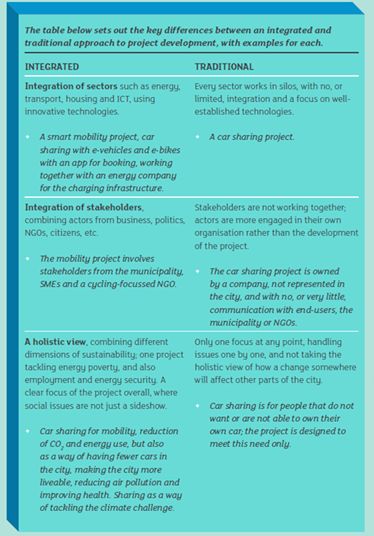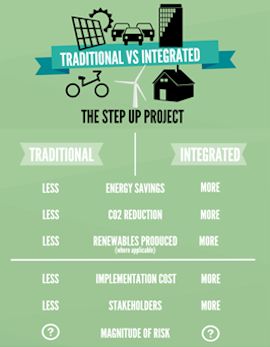The cities’ innovative projects have been evaluated and compared to show the impact of using the integrated approach instead of the traditional approach. The focus has been on energy and economics, but also on technology and innovation, stakeholders, risks and other policy objectives.
Cities considered what their projects would look like if a traditional approach was used instead of an integrated approach. A project with an integrated approach can be defined as a project that tries to achieve more “holistic solutions” to complex problems by integrating different kinds of stakeholders, sectors, technologies, and so on.

Key findings
The key findings when comparing the integrated approach with the traditional approach is that the integrated approach means:
- Better energy performance – in energy savings, CO2 emissions reduction and renewables production (where renewables generation is applicable to the project);
- Larger projects with often higher investment costs;
- Greater capacity to attract investment;
- More complex project organisation;
- Increased numbers of stakeholders involved;
- Increased benefits in all three sustainability dimensions – environmental, social and economic; and
- The need for a robust management structure.
The infographic below shows the overall conclusions in terms of energy performance, implementation costs, number of stakeholders and risks. However, it should also be recognised that there is a great variation between the projects; find out more by navigating through the tabs under ‘Innovative project development’ on the left of this page.
Traditional approach vs integrated approach – an overview of all innovative projects

Key recommendations
Recommendations for STEP UP cities interested in continuing to compare impacts from integrated and traditional approaches, or for other projects and initiatives looking follow a similar line of enquiry, include:
- Define relevant key words very clearly
- Compare similar projects
- Compare projects within the same time span, and with roughly the same pace of development
- Analyse projects from multiple perspectives
- Revisit projects later in the implementation stage to assess benefits delivered
There are also some recommendations relevant for cities interested in applying an integrated approach to their own project development:
- Consider using the integrated approach to solve complex problems
- Take a holistic view of the integrated approach
- Involve multiple stakeholders
- Consider project organisation early on
- Start to gather data as early as possible
- Use visual communication tools to present integrated projects to a wider audience
To read more about this work, the key features of the innovative projects using an integrated and traditional approach, and the recommendations above, download the STEP UP summary report here.
For further advice and recommendations on developing sustainable energy projects, please see the STEP UP guide here.
If you have any further enquiries about this work, please contact info@stepupsmartcities.eu